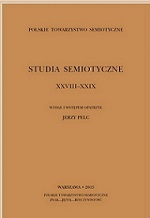Terminy (użycie precyzyjne a użycie potoczne) – o wyrazie tiret i wyrazach zbliżonych
Terms (Precise Use vs. Colloquial Use) – the Word Tiret and Related Words
Author(s): Zygmunt SaloniSubject(s): Semiotics / Semiology, Theoretical Linguistics
Published by: Polskie Towarzystwo Semiotyczne
Keywords: tiret; dash; hyphen; em-dash; en-dash; terms
Summary/Abstract: Punktem wyjścia rozważań jest wyraz tiret, który – zapożyczony z francuskiego – zdobył ostatnio znaczną frekwencję w polszczyźnie. Było go skutkiem wprowadzenia (w r. 2002) „Zasad techniki prawodawczej”: tiret jest jednostką kompozycyjną aktu legislacyjnego (w hierarchii: artykuł, paragraf, litera, tiret). Wszystkie wystąpienia wyrazu tiret w Narodowym Korpusie Języka Polskiego ilustrują to znaczenie, którego nie ma w języku francuskim. Dawniej bywał on używany w znaczeniu przejętym z francuskiego – słowniki języka polskiego notują wyraz tiret jako synonim łącznik (ang. hyphen). W podręcznikach gramatyki francuskiej tiret to myślnik czyli pauza (ang. dash), łącznik zaś – trait d’union. Jednak we francuskiej terminologii typograficznej wyrazu tiret używa się szerzej: na oznaczenie kreski poziomej stosowanej w druku; wyróżnia się tiret court, tiret moyen i tiret long, które odpowiadają w polskim wyrazom: łącznik, półpauza i pauza. Są to terminy techniczne, używane w typografii. W praktyce półpauzy i pauzy rozróżniają specjaliści, tymczasem łączniki (krótkie) i myślniki (dłuższe) są często mylone w piśmie, podobnie zaś są mieszane (używane nieformalnie) odpowiadające im terminy, i to w różnych językach. ===== The point of departure for this discussion is the word tiret in Polish. Borrowed from French, this term has recently gained considerable frequency in Polish. This is the result of its introduction into the “Principles of Legislative Technique”, accepted by the Polish authorities: tiret is therefore a given compositional unit of a legislative act (in the sequence: article, paragraph, letter, tiret). All the occurrences of the word tiret in the Polish National Corpus illustrate this meaning (which does not exist in French). Earlier, the word tiret was used in Polish in the sense taken from French, Polish dictionaries define it with the synonym, łącznik (‘hyphen’), which does not correspond to the meaning of the French word in French orthographic rules, where tiret is ‘dash’ (in Polish: myślnik or pauza), and where hyphen is named regularly as trait d’union. However, in the French typographic terminology the word tiret has a wider sense: it denotes all horizontal lines, used in print: therefore there have been three types of tiret distinguished: court, moyen and long, which correspond respectively to: em-dash, en-dash and hyphen (in Polish: łącznik, półpauza and pauza): these are technical terms, used by specialists in typesetting. In practice em-dashes and en-dashes are terms distinguished by professionals, while hyphens (short) and dashes (relatively long) are often mistaken in writing, similarly confused are (used informally) respective terms – in various languages.
Journal: Studia Semiotyczne
- Issue Year: XXIX/2015
- Issue No: 1
- Page Range: 283-301
- Page Count: 19
- Language: Polish

